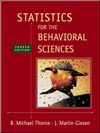| abscissa | the horizontal axis, or X axis, on a graph
|
 |
 |
 |
| ordinate | the vertical axis, or Y axis, on a graph
|
 |
 |
 |
| frequency polygon | graph of a frequency distribution; scores are plotted on the X axis, and frequencies are plotted on the Y axis
|
 |
 |
 |
| normal curve | symmetrical, bell-shaped curve whose tails never reach the X axis and whose measures of central tendency are identical
|
 |
 |
 |
| skewed curve | curve in which a large number of scores are piled up at one end, with a tail at the other end
|
 |
 |
 |
| positively skewed curve | skewed distribution with a tail toward the upper end of the X axis
|
 |
 |
 |
| negatively skewed curve | skewed distribution with a tail toward the lower end of the X axis
|
 |
 |
 |
| cumulative frequency curve | curve in which the cumulative frequencies are plotted over the scores
|
 |
 |
 |
| histogram | same as the frequency polygon except that rectangular bars are plotted over the scores rather than dots
|
 |
 |
 |
| bar graph | type of histogram used to graph nominal scale or categorical data; each bar is separated from its neighbors
|
 |
 |
 |
| stem-and-leaf plot | data display created by splitting each score into a stem and a leaf, listing the different stems from lowest to highest, and putting each leaf beside its stem
|
 |
 |
 |
| line graph | graph in which the independent variable is plotted on the X axis and some measure of the dependent variable is plotted on the Y axis.
|



 2003 McGraw-Hill Higher Education
2003 McGraw-Hill Higher Education